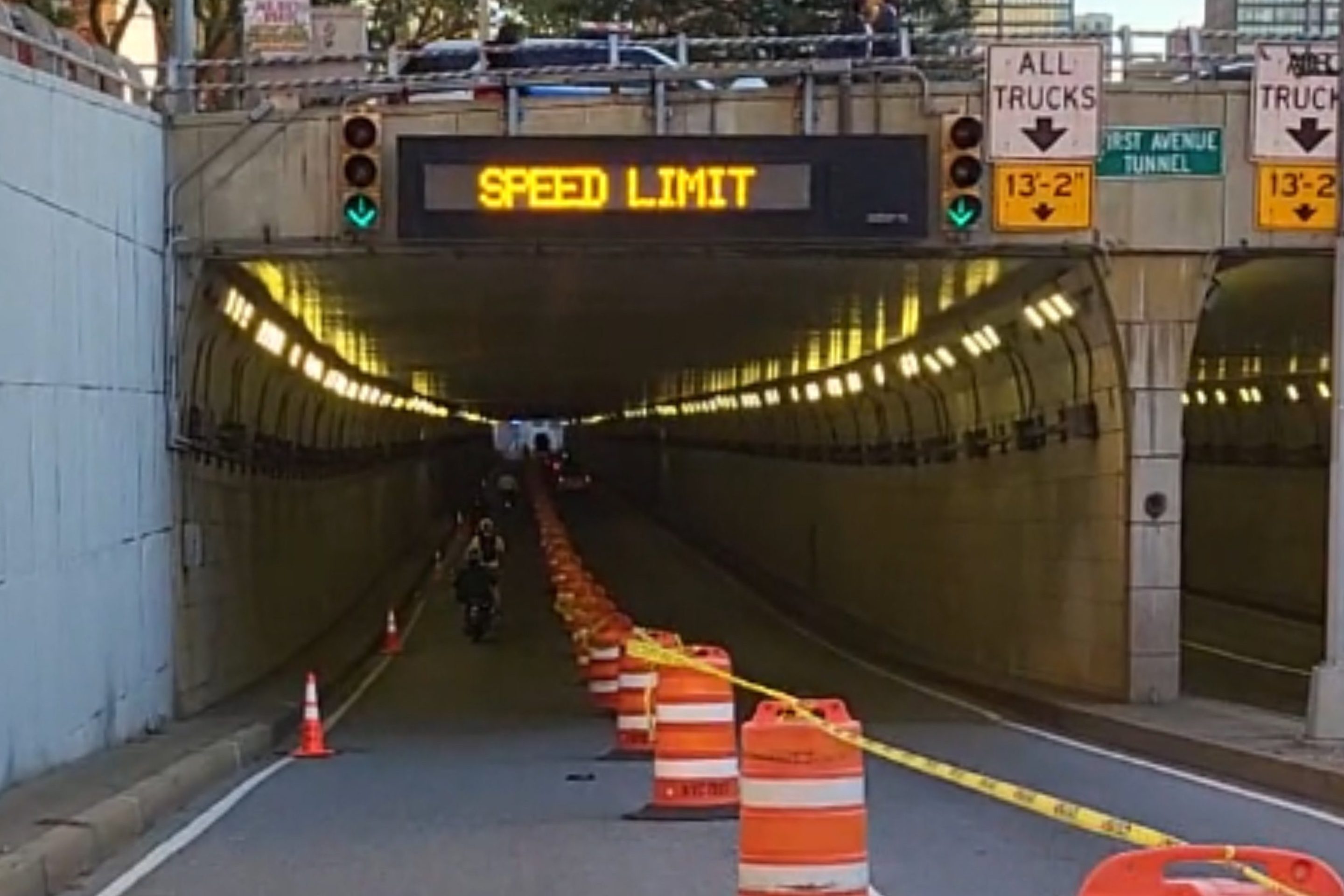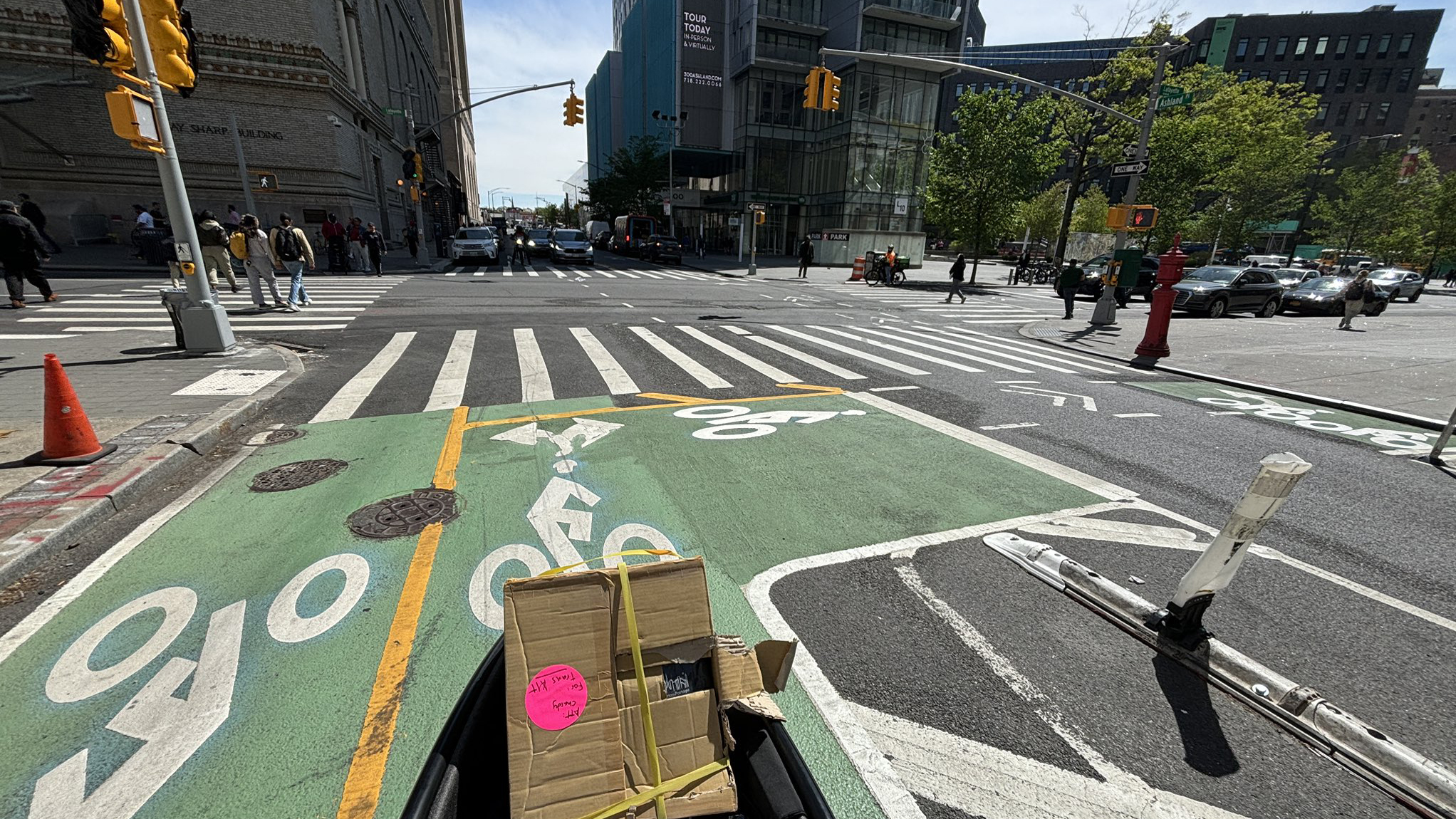Controversial Rotunda Project Proceeds Despite COVID Budget Woes
12:01 AM EDT on August 11, 2020
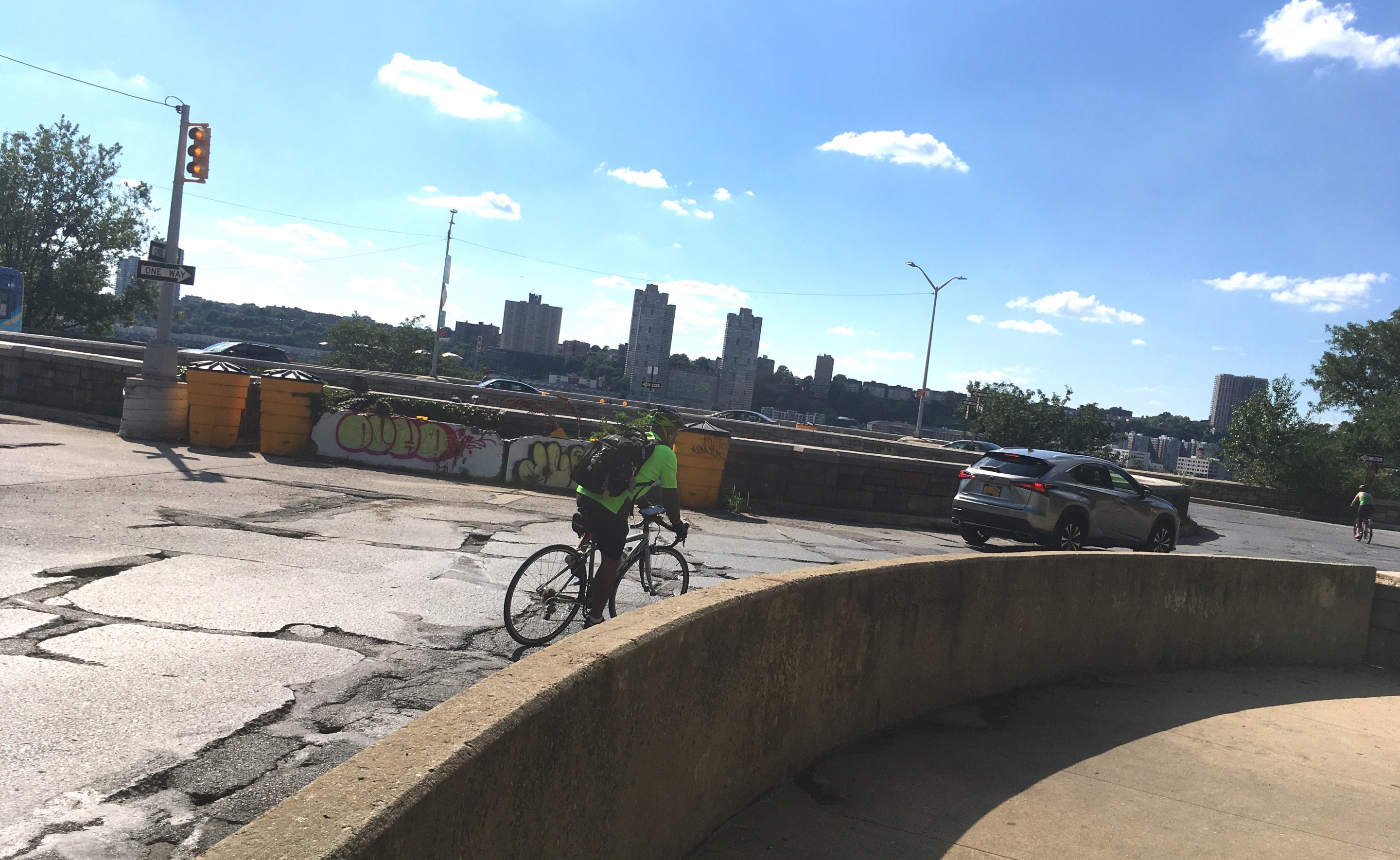
Cyclists and drivers mix in the traffic circle atop the Riverside Park Rotunda. Photo: Eve Kessler
The city is forging ahead with a controversial, $205-million Upper West Side project — a year after the local community board asked for safety revisions and despite COVID-sapped public budgets.
The Riverside Park Rotunda reconstruction — which would renovate a landmarked, Robert Moses-era park building; the traffic circle that sits atop it; and the 79th Street bridge, which carries the Henry Hudson Parkway next to it — will start at the close of the year with an anticipated completion date of 2024, the Department of Transportation confirmed; the City Record contains several recent solicitations for bids on contracts.
As part of the revamp, the DOT will create a painted lane in the traffic circle for cyclists — against the expressed wishes of Community Board 7 and local advocates who had demanded a physically protected bike lane.
“DOT does not provide safe passage for bicycles, but instead continues with the existing ‘meat-grinder’ Rotunda concept mixing cars and bikes in a traffic circle with two ramps on and off the West Side Highway,” said one local activist, Reed Rubey. “Physically separating bikes and cars to avoid crashes is paramount, especially with the increased bike usage throughout NYC now during COVID and beyond. This project must be redesigned to provide safety for all users.”
The traffic circle — a narrow roundabout with no shoulders, like other Moses roadways such as the Brooklyn-Queens and Cross Bronx expressways — originally served only as a grand entrance to the Upper West Side for the hundreds of car drivers exiting daily from the Henry Hudson Parkway.
In recent decades, however, the circle has become the gateway for cyclists seeking access to the nation’s busiest bike path, the Hudson River Greenway. The two groups of users mix dangerously in its narrow bowl.
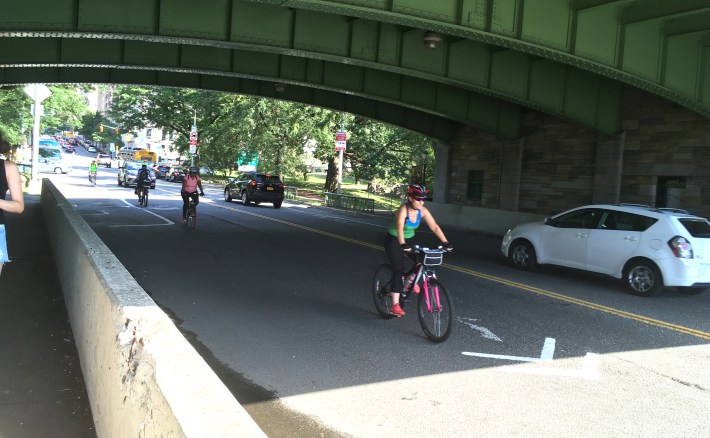
Last year, Community Board 7 formally “disapproved” of the DOT’s plan.
"I am very troubled that at a time the city's revenues are plummeting and all sorts of essential services face cuts, the city is going ahead with this particular quarter-billion-dollar reconstruction project," said Howard Yaruss, the co-chairman of the CB7 transportation Committee, emphasizing that he was sharing his personal opinion. "If this truly extraordinary sum of money is nevertheless going to be spent, at the very least it should enable safe passage for all users, as CB7 requested."
Speaking for the board, Chairman Mark Diller added, "Previous iterations of the traffic circle plan included treatments that would have required cyclists and motorists to share a lane of traffic (along with the M79-SBS articulated bus), and that the final plan calls for a separate bike lane. The Board's resolution underscores the need for the separate bike lane to be a protected lane and not just paint on a heavily used roadway."
The lack of cycling safety in the circle earlier had prompted some community members, especially cycling activists, to develop several proposals for alternate bike paths that avoided the circle. But the DOT rejected all those ideas and, ultimately, the board’s recommendations — which are only advisory.
“Current bicycle facility design guidance from the American Association of Transportation Officials does not allow for new bike lanes with the circulatory pattern of traffic circles,” DOT Commissioner Polly Trottenberg told Comptroller Scott Stringer in a letter in December that explained DOT’s rejection of the community board’s demands.
But the agency did study the proposals and made some minor changes, Trottenberg said, including painting the bike lane green and seeking to reduce vehicle-bicycle conflict by changing a "Yield" sign to a "Stop" sign.
"This was deemed to provide the safest solution for all user groups while maintaining operational aspects and protection of the landmarked property,” she wrote.
Some think the DOT could do better.
“All sides should look into putting in a protected bike lane, even if it doesn’t meet AASHTO standards,” said Adrian Benepe, a former city parks commissioner and avid cyclist, noting that many things don’t meet AASHTO standards and work just fine.
Benepe pointed out, however, that the reconstruction includes ADA-compliant ramps from the top of the Rotunda to the mezzanine level and then down into the park — and that such structures, if continuous and able to accommodate cyclists, might allow cyclists an alternative route to the Greenway without entering the traffic circle. (The issue of the Greenway bypass that routes cyclists around the 79th Street Boat Basin is another controversial subject that is too complicated to address here.)
The DOT responded that the ramp idea isn't doable, because "the geometry of the existing Rotunda structure is not compatible with a new ramp of sufficient width to accommodate all user types without major modifications to the landmarked facility."
Remnant of a different time
The Rotunda, a large, hollow, round, 1937 structure, is, indeed, a landmark — and a fraught one, at that.
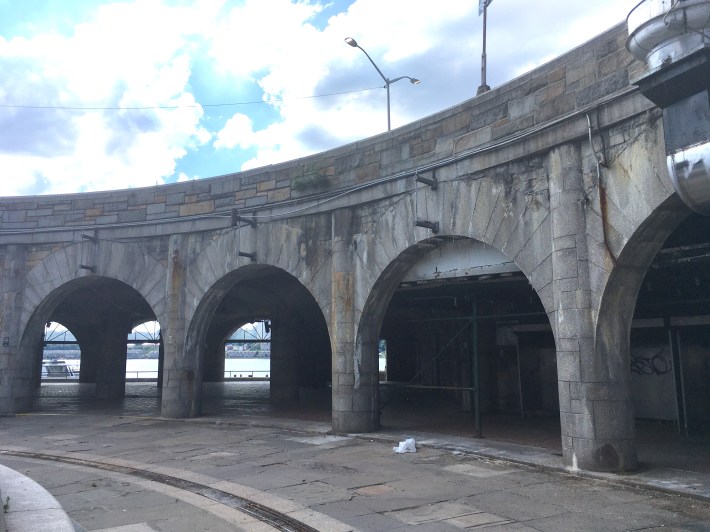
Besides its status as a monument to car culture, the building — a blocky, modernist take on Rome’s Coliseum — is also reminiscent of 1930s monumental Nazi architecture. Moses was heavily influenced by such Fascist European planners as Le Corbusier, as many (especially Jane Jacobs) have noted; it’s not an exaggeration to say that the Rotunda shares some architectural DNA with such mid-1930s totalitarian buildings as the Nuremberg Kongresshalle (1935, below).
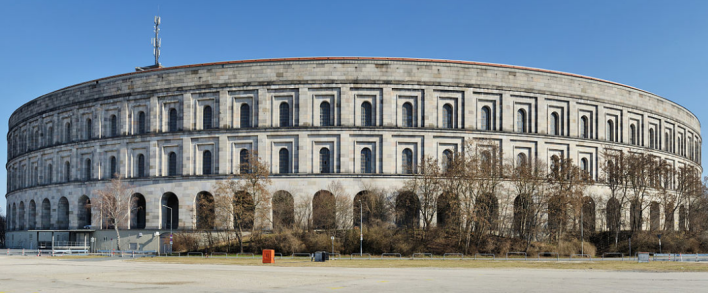
Like those grandiose monuments, it is designed to accommodate spectacles (see the accompanying photograph of its 1937 opening ceremony) and to present a stirring panorama when viewed from the air.
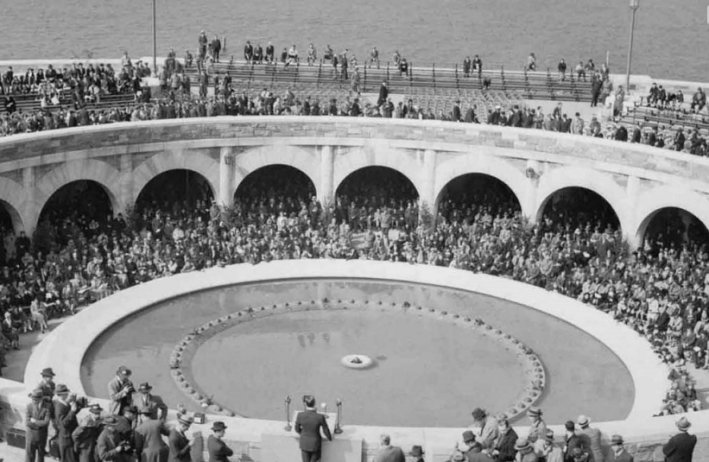
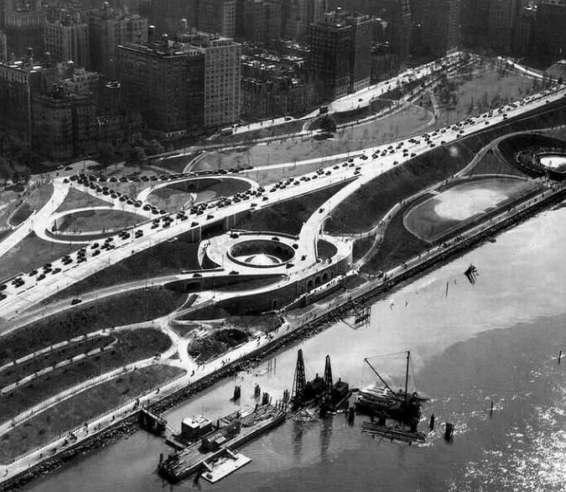
Of course, there’s a certain irony and perversity in the fact that Moses (who was of German Jewish extraction) built such a colossus on the Upper West Side, which at the time of the Rotunda’s construction was filling up with German-Jewish refugees of Nazism. Welcome to New York!
Be that as it may, the 83-year-old Rotunda, which has never been renovated, is a forlorn wreck whose deterioration has troubled city planners since the 1990s; even the cafe that long operated there, serving park goers and residents of the adjacent 79th Street Boat Basin, has vacated. The graffiti-stung traffic circle clearly needs resurfacing; the trusses under the 79th Street Bridge appear to be freshly painted, but the structure itself sports a crack.
The vast majority of the $205 million for the Rotunda reconstruction —$165 million — is in the Parks Department budget; it’s for fixing the building, not the roads around it. Plans detail a gut renovation of each of the Rotunda’s three levels, with a new fountain to replace the defunct one at the building’s center, a new kitchen (with venting), offices, concession space and garage, the accessible ramp, and swank surfaces such as Deer Isle granite and Gustavino tiles.
Is the Rotunda a first-order project in an age of extreme budget austerity?
The DOT has a “very troubling long-term fiscal picture,” Trottenberg said last week during a Zoom meeting sponsored by the Regional Plan Association. Its $1.1-billion budget has taken a 12-percent cut, “which is not an easy one to swallow” given its many fixed costs. The department needs to “prioritize,” she continued, “and there are some things that are going to have to come off the list.”
That’s not likely to be the Rotunda, however — especially because the roadwork is packaged together with fixing the building. CB7 approved of the historical renovation aspects of the Rotunda project in a July 2, 2019 resolution.
“I think it is a reasonable spend,” said Nicole Gelinas, a senior fellow at the fiscally conservative Manhattan Institute. “It’s basically falling apart.”
Certainly that can be said of a lot of vital infrastructure. New Yorkers might examine this project, on which they are spending a vast sum, with any eye toward making it work better for people rather than cars. Instead of moving hundreds of cars daily into the Upper West Side — with the attendant congestion, pollution, and stress on parking — in a better world the traffic circle might be closed to parkway traffic and function as a local roundabout, a grand gateway into the park for users.
No movement is pushing for such an outcome — but there is precedent. In 2005, the northbound parkway exit was closed at 72nd Street at the behest of the developer of a project then called Riverside South. His name? Donald Trump.
Stay in touch
Sign up for our free newsletter
More from Streetsblog New York City
DOT Aims to Build First Avenue Tunnel Bike Lane Before September’s UN General Assembly
DOT hopes to have the concrete-protect tunnel bike lane installed this summer, but its exact plans are still in development.
Waste Reforms Could Require Data on Crashes, Dangerous Driving
The proposal affects at least one trucking company with a deadly driving record.
When it Comes to Federal Infrastructure Grants, Size Does Matter
Cities and municipalities with larger budgets and staff are more likely to win competitive federal infrastructure grants, the Urban Institute has found.
Tuesday’s Headlines: Real Estate Greed Against Good Bike Lane Design Edition
A real estate developer's opposition to the Ashland Place protected bike lane yields some baffling bike lane markings. Plus more news.
City Considers Fixes for Another Ridiculously Slow Cross-Bronx Bus
Potential bus improvements are on the table for the Bronx's Tremont Avenue, but the Adams administration's failures on nearby Fordham Road loom large.
